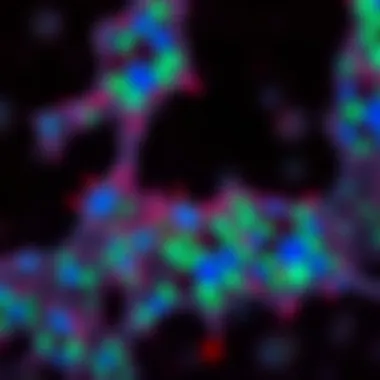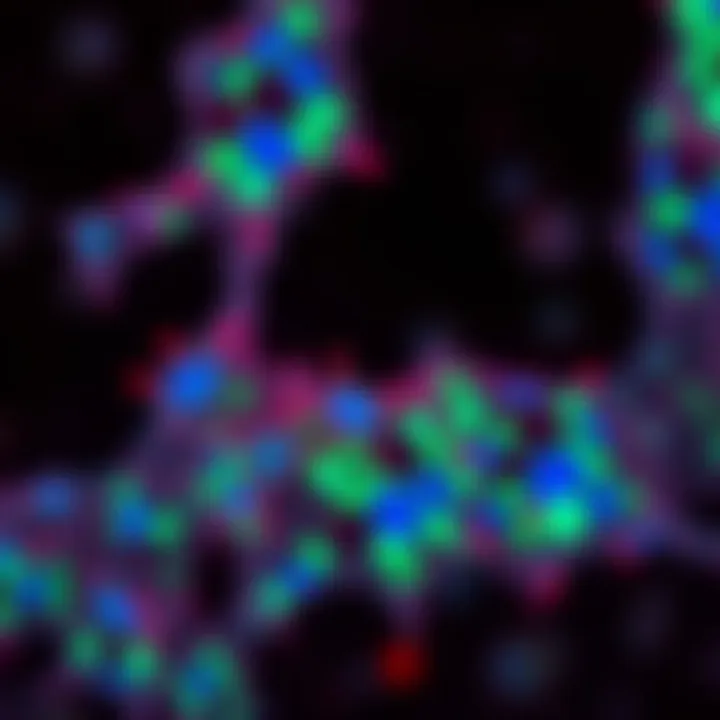Monoclonal Antibodies and Immunofluorescence Insights


Intro
Microscopic immunofluorescence techniques have emerged as cornerstone methods in the biological and medical sciences, linking both researchers and healthcare professionals to invaluable insights into cellular function and disease state. Central to these techniques are monoclonal antibodies, which have made dramatic contributions to diagnostics and therapeutics. The marriage of monoclonal antibodies with immunofluorescence techniques enables detection and visualization of specific proteins in complex biological samples, thus shedding light on cellular interactions and mechanisms of disease.
In recent years, as science has made strides in understanding the molecular intricacies of life, the role of monoclonal antibodies has become increasingly prominent. Their specificity and ability to bind to distinct antigens facilitate targeted approaches for both research and clinical applications. This exploration into their functionality, paired with advanced imaging techniques, can help in crafting novel therapeutic approaches alongside enhancing diagnostic capabilities.
Prelude to Monoclonal Antibodies
Understanding monoclonal antibodies is crucial in the landscape of modern science. These proteins hold the key to various applications in diagnostics, therapeutics, and research, making them indispensable in the fields of medicine and biology. In this section, we will examine their definition, historical context, and the different types available.
Definition and Characteristics
Monoclonal antibodies are identical antibodies produced by a single clone of immune cells. They are designed to bind to specific antigens, which are unique molecules present on the surface of pathogens or diseased cells. What distinguishes these antibodies is their uniformity, as they target a single epitope on an antigen. This specificity is their strength, allowing for precise detection and targeting, which is a game changer in both diagnostic tests and therapy. Moreover, monoclonal antibodies can be engineered to perform various functions, such as blocking or activating biological pathways, enhancing their utility further.
History and Development
The origins of monoclonal antibody technology trace back to the 1970s when Georges Köhler and César Milstein developed hybridoma technology. This innovative method allowed for the creation of hybrid cells that produce large quantities of a specific antibody. Since then, the field has blossomed. The first licensed monoclonal antibody product, muromonab-CD3, appeared in the 1980s, primarily for use in transplant medicine. Today, we see a multitude of monoclonal antibodies, from those targeting cancer cells to those combating autoimmune diseases, thanks to ongoing advancements in biotechnology.
Types of Monoclonal Antibodies
Monoclonal antibodies can be categorized based on their source and structure. The common types include:
- Murine antibodies: Made from mouse cells. They can provoke immune responses in humans, limiting their therapeutic use.
- Chimeric antibodies: Comprise both murine and human components, which reduces the risk of immune reactions.
- Humanized antibodies: Mostly human, with small murine segments added for functionality. They find widespread use in therapies and diagnostics.
- Fully human antibodies: Created using advanced technologies that eliminate any mouse components, minimizing immunogenicity and enhancing patient safety.
Understanding the distinctions among these antibody types plays a critical role in selecting the appropriate candidates for specific applications.
"Monoclonal antibodies represent a step into a new frontier for understanding and treating disease, demonstrating both the brilliance of scientific inquiry and the power of technological advancements."
In summary, the introduction to monoclonal antibodies sets the stage for their roles in immunological applications. Each characteristic and type directly informs their utility in research and therapies, affirming their position as pivotal players in the ongoing quest for medical breakthroughs.
Fundamentals of Immunofluorescence
Understanding the fundamentals of immunofluorescence is pivotal to grasping how monoclonal antibodies operate at a molecular level. This section delves into the core principles of immunofluorescence, showcasing the mechanisms by which it enhances the visibility of specific cellular structures and biomolecules. By employing fluorescent labels, researchers can map the intricate choreography of proteins and other components within cells, ultimately aiding in both diagnostics and therapeutic innovations. The potential for these techniques in biological research cannot be overstated, as they bridge gaps in our understanding of cell function and pathology.
Overview of Immunofluorescence
Immunofluorescence is a technique that enables visualization of the presence and locations of specific proteins or antigens in various biological samples. At its essence, it combines the specificity of antibodies with the sensitivity of fluorescence microscopy. This dual approach allows researchers to see proteins tagged with fluorophores, making it easier to study complex biological interactions.
A typical immunofluorescence experiment begins with the fixation of cells on a slide, preserving their physiological state. Then, a primary antibody specific to the target antigen is applied. After a wash step to remove unbound antibodies, a secondary antibody—conjugated to a fluorophore—is added. This secondary antibody recognizes the primary antibody, amplifying the signal for visualization.
This method provides unparalleled insight, making it an indispensable tool for disciplines ranging from cell biology to diagnostic medicine.
Fluorescent Dyes and Labels
The choice of fluorescent dyes profoundly influences the outcome of immunofluorescence experiments. These dyes, or fluorophores, are responsible for the emission of light when excited by a source, often a laser or high-intensity lamp. Different dyes have unique properties, such as excitation and emission wavelengths, which dictate their usefulness in multiplexing techniques. Some commonly used fluorescent dyes include:
- Fluorescein isothiocyanate (FITC)
- Cy3 and Cy5
- Alexa Fluor™ series
When selecting a fluorophore, it is crucial to consider the spectral overlap, photostability, and brightness of the dyes chosen. A well-thought-out selection can minimize background noise and enhance contrast, allowing clearer visualization of the target.
"The development of fluorescent dyes is akin to that of colorful pencils for an artist; the right choice can add vibrancy and depth to the final picture."
Microscopic Techniques Overview
In modern biological research, several microscopy techniques are employed for immunofluorescence, each with its particular advantages and challenges. The most commonly used ones include:
- Widefield Microscopy: Easy to use and cost-effective, but can suffer from out-of-focus light.
- Confocal Microscopy: Provides higher resolution images and the ability to capture three-dimensional structures by using point illumination and spatial filtering.
- Total Internal Reflection Fluorescence (TIRF) Microscopy: Ideal for examining dynamic processes at the membrane level, but requires specific sample conditions.


The choice of microscopy techniques depends on the specific goals of the study. Each method brings its own set of tools and best practices that contribute to the overall quality of data obtained. Adapting these methodologies to the questions at hand is fundamental to maximizing the information gleaned from samples, making this knowledge essential for researchers.
Mechanisms of Action
Understanding the mechanisms of action of monoclonal antibodies (mAbs) is pivotal in grasping their role within immunofluorescence techniques. These mechanisms not only dictate how monoclonal antibodies interact with specific targets but also illustrate the downstream effects of these interactions within biological systems. The precision with which these antibodies bind to antigens transforms them into invaluable tools for both research and clinical diagnostics.
How Monoclonal Antibodies Bind to Antigens
Monoclonal antibodies exhibit a unique specificity for their targeted antigens due to the uniqueness embedded in their structure. This selective affinity is rooted in the variable regions of the antibody, which contains specific amino acid sequences capable of binding exclusively to the corresponding epitope of the antigen. When a monoclonal antibody encounters its antigen, a series of conformational changes occur, facilitating a stronger interaction.
- Antigen-Antibody Complex Formation: Initially, the antibody attaches to the antigen, forming a complex that can be visualized through immunofluorescence.
- Affinity and Avidity: The strength of this binding (affinity) and the total number of binding sites engaged (avidity) significantly influence the effectiveness of the antibody in assays. High-affinity antibodies are more successful in detecting low-abundance targets.
- Isotype Influence: Different classes of antibodies (IgG, IgM, etc.) play distinct roles in the binding process, influencing not only the binding but also subsequent immune responses.
Understanding these binding mechanisms is crucial for optimizing the use of monoclonal antibodies in research and diagnostics, ensuring reliable and reproducible outcomes.
Signal Transduction via Immunofluorescence
Once the monoclonal antibody binds to its target antigen, it initiates a cascade of biological signals that can be monitored through immunofluorescence techniques. The immunofluorescence method fundamentally relies on the light emitted by fluorescent dyes attached to the antibodies. This emitted light serves as an essential tool to reveal the location and concentration of the antigen within the sample.
- Fluorescent Labels: The choice of fluorescent labels can impact the sensitivity of detection. For instance, brilliant dyes may yield brighter signals, improving visibility, whereas others might be more suited for specific applications.
- Quantitative Analysis: By assessing the intensity of fluorescence, researchers can quantitatively measure the expression levels of the antigens in various samples.
- Non-Specific Binding: One must also consider the implications of non-specific binding as it can complicate signal interpretation and ultimately lead to faulty conclusions.
In summary, the mechanisms of action of monoclonal antibodies encompass both their binding to antigens and the subsequent signal transduction pathways activated within the samples. An in-depth understanding of these processes not only enhances the effectiveness of monoclonal antibody applications but also promotes the advancement of methodologies within the field of immunofluorescence.
Applications of Monoclonal Antibodies
Monoclonal antibodies hold a pivotal place in modern biology and medicine, acting as versatile tools with a plethora of applications across various fields. Their precise targeting mechanism allows them to interact directly with specific antigens, making them invaluable in diagnostics, therapeutics, and research. In this section, we will explore the vital roles that monoclonal antibodies play in these arenas, discussing their practical benefits and the considerations involved in their use.
Diagnostic Applications
Diagnostic applications of monoclonal antibodies serve as a cornerstone in healthcare, providing clinicians with accurate tools for disease identification and management. By binding specifically to unique antigens present in pathogens or diseased tissue, these antibodies enable the detection of diseases such as cancer, infectious diseases, and autoimmune disorders.
For instance, the use of Herceptin, a monoclonal antibody that targets the HER2 protein, is a game changer in breast cancer diagnostics. It helps in determining the HER2 status of tumors, guiding treatment options effectively.
"Monoclonal antibodies simplify the often-complex processes of diagnosing diseases by focusing on specific markers, enhancing accuracy."
The advantages of diagnostic applications include:
- Increased accuracy: By targeting specific antigens, they reduce the chances of false positives and negatives, aiding in more precise diagnosis.
- Early detection: With the sensitivity of immunofluorescence techniques, earlier stages of disease can be identified, leading to prompt treatment.
- Personalized medicine: These antibodies pave the way for individualized treatment plans tailored to the unique characteristics of a patient’s disease.
Despite their benefits, factors such as the cost of monoclonal antibody production and the potential for variability in antibody performance need to be considered carefully when implementing these diagnostic tools.
Therapeutic Uses
Monoclonal antibodies also have an extensive range of therapeutic applications, acting as targeted treatments for various diseases, particularly cancers. They tend to be designed to either interfere with the activity of specific cells or mark them for destruction by the immune system.
A prime example is Rituxan, which binds to CD20 on B-cells, and has shown significant efficacy in treating lymphomas and leukemias. These therapies not only target cancerous cells but also often come with fewer side effects compared to traditional chemotherapy.
Benefits of therapeutic applications include:
- Targeted action: Monoclonal antibodies can hone in on specific cells or pathways, offering treatment that is less harmful to surrounding healthy tissues.
- Immunomodulation: Some antibodies encourage the immune system to respond more vigorously to tumors, enhancing the body’s natural defenses against cancer.
- Combination strategies: Monoclonal antibodies can be used in conjunction with other treatments, such as chemotherapy or radiation, for a synergistic effect.
Nonetheless, achieving optimal therapeutic outcomes requires meticulously managing treatment regimens, addressing potential resistance, and considering patient-specific factors that influence antibody efficacy.
Research Applications
Aside from diagnostics and therapies, monoclonal antibodies are indispensable in scientific research, contributing to our understanding of complex biological processes. They serve as crucial reagents in various experimental setups, helping researchers to explore protein interactions, cell signaling pathways, and overall cellular behavior.
For example, scientists utilize antibodies in techniques like Western blots, ELISA, and immunoprecipitation to dissect components of signaling pathways in cancer cells. Their specificity enhances assay reliability, permitting clearer insights into cellular mechanisms.
Key advantages of using monoclonal antibodies in research include:


- Reproducibility: Consistent specifications ensure that results can be reliably replicated in different experiments.
- Versatility: With a broad range of species and targets they can bind to, their applications span from basic research to drug development.
- Increasing accuracy in immunology: Monoclonal antibodies help identify immune responses in pathological settings, allowing for a better understanding of diseases.
In summary, monoclonal antibodies are not just laboratory instruments; they shape modern medical interventions and scientific exploration beyond the norm. The potential for deeper insights and innovative treatments highlights their lengthy journey ahead in the realms of diagnostics, therapeutics, and research.
Integrating Monoclonal Antibodies and Immunofluorescence
The integration of monoclonal antibodies with immunofluorescence techniques represents a symbiotic relation that significantly enhances our ability to observe biological processes at the microscopic level. This combination not only enriches our understanding but paves the way for novel therapeutic applications in various fields such as diagnostics and research. In this section, we will explore the specific elements and benefits that continue to underscore the importance of fusing these two potent methodologies.
Synergy in Research
When researchers venture into the world of cellular biology, the marriage of monoclonal antibodies and immunofluorescence opens up a wealth of possibilities. Monoclonal antibodies, known for their specificity in targeting antigens, allow scientists to identify and isolate particular cells or proteins within a complex mixture. This specificity is particularly advantageous in studies involving disease states or developmental processes.
For instance, consider cancer research. Using fluorescently labeled monoclonal antibodies, researchers can pinpoint tumor cells within a tissue sample. This straightforward application not only aids in diagnostics but also helps in monitoring how cancer therapies affect cellular populations over time. With the power to visualize cellular interactions in ways previously deemed unattainable, many researchers have shifted their attention to unraveling novel therapeutic pathways and gene functions.
Enhancing Visualization Techniques
In the pursuit of biological insights, clarity matters. The fusion of monoclonal antibodies with immunofluorescence dramatically enhances visualization techniques used in cellular research. The application of various fluorescent dyes on these antibodies allows for multi-color labeling, creating a vivid, comprehensive image of complex cellular environments.
The use of advanced microscopy methods, like confocal microscopy, benefits significantly from this integration. This technology provides three-dimensional images, enabling researchers to observe not only the presence of proteins but also their spatial relationships and interactions within the cell.
This level of detail helps elucidate protein dynamics over time, which is critical when studying processes like cellular signaling or pathogen response. Moreover, the reduction of background noise from unbound antibodies enhances the signals of interest, which means researchers can extract meaningful data amidst all the biological chatter.
By leveraging monoclonal antibodies in conjunction with immunofluorescence, the visualization capabilities of microscopic techniques are not just enhanced; they are revolutionized.
To summarize, the integration of monoclonal antibodies with immunofluorescence is pivotal for elevating cellular research. The synergy that results from this combination paves the way for innovative approaches to understanding complex biological systems, ultimately contributing to advancements in healthcare and scientific inquiry.
For more detailed insights, refer to reliable sources such as Wikipedia or Britannica.
Methodological Approaches
In the exploration of monoclonal antibodies through microscopic immunofluorescence techniques, methodological approaches play a vital role. The backbone of effective research hinges on the methods chosen for sample preparation, the imaging technologies employed, and the interpretive strategies applied. Each aspect is interconnected, contributing to a coherent narrative in understanding how antibodies engage with antigens at a cellular level.
Preparing Samples for Analysis
Sample preparation is more than just an initial step; it sets the stage for what follows. Properly prepared samples ensure that subsequent imaging and results are reliable. Steps involved in this process generally include fixation, permeabilization, and blocking. Fixation preserves cellular structures and makes antigens accessible to antibodies.
Permeabilization, on the other hand, allows antibodies to infiltrate the cell membrane. A good blocking agent is essential to prevent non-specific binding of antibodies, which can create noise in the final images. Researchers often employ agents such as BSA or serum from non-specific species to carry out this blocking effectively.
Some common strategies in sample preparation might involve:
- Choosing the right fixation method: Different tissues may respond better to harsh or mild fixatives.
- Optimizing concentration of blocking agents: Too much can interfere, but too little invites non-specific binding.
Since the absolute quality of images hinges on the sample stage, meticulous care during preparation often bears fruit in the form of clear and interpretable results.
Using Confocal Microscopy
Confocal microscopy serves as a robust tool in our quest to visualize monoclonal antibodies effectively. This technique provides a significant advantage in its ability to produce high-resolution images with excellent depth perception. Practitioners often find it particularly useful for examining thick samples, where traditional microscopy may falter.
The principle of confocal microscopy relies on a focused laser beam that scans the specimen and collects emitted fluorescence one pixel at a time. This contrasts sharply with conventional microscopy, which captures light from all depths of the sample at once, resulting in a loss of detail.
Benefits of employing confocal microscopy include:
- Enhanced Spatial Resolution: The use of pinholes enables the elimination of out-of-focus light, resulting in sharper images.
- 3D Imaging Capabilities: By collecting multiple images at different depths, a three-dimensional perspective becomes accessible, invaluable when studying complex structures.
Researchers often marry different types of fluorescent markers with confocal microscopy to enhance the outputs, thus pushing the boundaries of what is visible within cellular environments.
Interpreting Results from Immunofluorescence


Interpreting results from immunofluorescence studies encompasses a challenging yet ultimately rewarding endeavor. The fluorescence emitted from antibody-antigen complexes requires careful analysis to maximize understanding. Here, the challenges arise not only from data quality but also from distinguishing signal from noise.
An effective interpretation process often involves:
- Setting Appropriate Controls: Including all necessary controls to determine background levels and specific binding scenarios.
- Using Image Analysis Software: Tools such as Fiji or ImageJ assist in quantifying fluorescence intensity or co-localization studies.
The common pitfalls in interpretation lie in over-reliance on visual inspection. This can lead to mistaken assessments of efficacy or abundance based solely on fluorescence intensity, rather than taking statistical or normalized values into account. Thus, the transition from observation to conclusion must be made with an eye for detail to ensure the findings are reliable and significant.
"In the world of scientific research, data without context is just noise; interpretation gives it meaning."
By integrating these methodological approaches into the study of monoclonal antibodies, researchers can better navigate the complexities of immunofluorescence. With these foundations, advancements in diagnostics and therapeutic strategies become increasingly viable, paving the way for progress in cellular research.
Challenges and Limitations
The examination of monoclonal antibodies through immunofluorescence is not without its challenges and limitations. Addressing these hindrances is crucial for several reasons. Firstly, understanding these boundaries aids researchers in designing more robust experiments and interpreting their findings accurately. Secondly, acknowledging limitations highlights areas where the field can evolve and innovate, which ultimately benefits diagnostics and therapeutic developments. It's imperative to strike a balance between ambition in the lab and the caution warranted by technical difficulties. This careful approach enhances the reliability of results derived from such complex methodologies, ensuring that they contribute valid insights into cellular processes and disease mechanisms.
Technical Limitations in Microscopic Techniques
Microscopic techniques, despite their vast potential, face a variety of technical limitations that can leave researchers scratching their heads. One significant issue is the challenges related to resolution. When studying small structures, such as organelles or antibody-antigen complexes, conventional light microscopy may not provide the resolution necessary to appreciate the nuanced details. For instance, diffraction limits the ability to distinguish closely spaced antigens, leading to potential misinterpretations.
Moreover, phototoxicity is another crucial concern. Prolonged exposure to fluorescent light can damage biological samples or alter cellular processes. This is particularly problematic when studying live cells, where the viability of the sample is paramount. In some cases, excessive fluorescence could lead to signal saturation, rendering data unusable due to an inability to discern meaningful colors or intensities.
Other issues include sample preparation and artifacts. Inadequate fixation techniques can lead to loss of antigenicity, meaning antibodies might not bind as expected. This would throw a wrench into the analysis, so researchers must nail down their techniques to avoid false negatives. Thus, taking a proactive stance on these technical limitations is vital for successful outcomes.
Variability in Antibody Performance
Antibody performance can be as fickle as the weather, often varying significantly across different experiments. This variability can stem from numerous sources. Firstly, the batch-to-batch variation seen in monoclonal antibodies poses a real headache. Different production batches can yield antibodies that behave inconsistently, making reproducibility a daunting prospect.
Additionally, antibodies can exhibit variations in specificity and sensitivity. A monoclonal antibody that works wonders in one experiment may fail to recognize its target in another, owing to changes in the sample's state or the presence of different cellular contexts. The specificity can diminish due to post-translational modifications in proteins, thus affecting binding affinity.
It's also important to recognize that environmental factors, like temperature and pH, play influential roles. If even a minor detail goes awry during an experiment, it can jeopardize entire sets of results, casting shadows of doubt on previous findings. As a result, employing rigorous quality control measures and developing standardized protocols is vital to mitigate the impact of variability in antibody performance. In this way, researchers can better ensure the reliability of their results and interpretation.
Future Prospects
The future of monoclonal antibodies and microscopic immunofluorescence presents an exciting landscape filled with opportunities for advancement. As research in these fields continues to evolve, several pivotal elements will shape their trajectory. These include advancements in antibody engineering and novel imaging technologies, both of which play crucial roles in enhancing diagnostic capabilities, therapeutic options, and our understanding of complex biological processes.
Advancements in Antibody Engineering
The landscape of antibody engineering is undergoing rapid transformation driven by innovative methodologies. Researchers are exploring techniques such as phage display and genetic engineering to create monoclonal antibodies with greater specificity and affinity. This precision is crucial in both diagnostics and therapeutics, as it can lead to improved targeting of disease markers and enhanced treatment efficacy.
- Optimizing Specificity: Recent studies have demonstrated how novel approaches can refine the specificity of monoclonal antibodies, reducing off-target effects. This optimization is a game changer in therapeutic applications, ensuring that treatments are not only effective but also safe, minimizing potential side effects that could arise from less specific treatments.
- Bispecific Antibodies: Another area of growth is the development of bispecific antibodies, which can simultaneously bind to two different antigens. This capability opens up avenues for targeted therapy, particularly in cancer treatment, allowing for a dual attack on tumor cells while sparing healthy tissue. The promise of bispecifics is gradually being realized, and ongoing clinical trials will likely provide valuable insights into their effectiveness.
- Nanoformulations: Advances in nanotechnology are also set to revolutionize the field. Researchers are investigating antibody conjugates and nanoparticles that can deliver therapeutic agents directly to specific cells, enhancing treatment precision and efficacy. This combination could potentially limit systemic side effects associated with conventional therapies.
Novel Imaging Technologies
Innovation is not only transforming antibody engineering but also the imaging technologies utilized in immunofluorescence. New imaging methods are making it possible to capture cellular processes with unprecedented detail and accuracy. Here’s a glimpse into what's on the horizon:
- Super-Resolution Microscopy: Technologies like STED (Stimulated Emission Depletion) microscopy or PALM (Photo-Activated Localization Microscopy) allow for visualization at the nanoscale. This level of resolution provides insights into molecular interactions within cells, facilitating a deeper understanding of cellular dynamics and disease mechanisms.
- Real-Time Imaging: The integration of real-time imaging with immunofluorescence techniques is set to enhance research capabilities. This approach allows scientists to observe live cell interactions and processes, leading to better understanding of the temporal dynamics of immunological responses.
- Multi-Modal Imaging: The convergence of various imaging modalities, such as combining immunofluorescence with MRI or PET scans, promises to deliver a more holistic view of biological systems. This layered approach can improve diagnostic processes, providing comprehensive insights into disease progression.
"Innovation in antibody engineering and imaging technologies is not just a step forward; it's a leap into uncharted territories of biomedical research."
With these advancements in antibody engineering and imaging techniques, the future holds great promise for both clinical and research settings. The potential for innovation in monoclonal antibodies and immunofluorescence techniques can lead to breakthroughs in diagnostics and treatment that were once merely aspirational. As knowledge expands and technologies converge, new frontiers are bound to emerge, further enriching our understanding of the complex biological tapestry that defines health and disease.
The End
In summary, the exploration of monoclonal antibodies through microscopic immunofluorescence serves not just as a scientific inquiry but as a crucial step in enhancing our understanding of complex biological systems. This conclusion ties together the threads from each section, highlighting essential aspects such as the specificity of monoclonal antibodies, their methodological use with immunofluorescence, and the transformative potential they hold in both diagnostics and therapeutic realms.
One of the key insights gathered is the remarkable precision with which monoclonal antibodies can target specific antigens, which tremendously benefits researchers and medical professionals aiming to detect diseases at earlier stages. The ability to visualize these interactions under a microscope allows for detailed studies of cellular processes, bridging a vital gap in our comprehension of how diseases progress. This precision, when coupled with advanced imaging technologies, opens up new avenues for intervention strategies, ensuring that future healthcare solutions can be both effective and tailored to individual needs.
Moreover, the continued incorporation of novel imaging techniques not only enhances the resolution of detected signals but also contributes to a more comprehensive understanding of dynamic cellular events in real time. This synergy emphasizes why collaboration among disciplines is pivotal in fostering innovation and pushing the boundaries of what is currently understood in biomedicine.
"The future of healthcare lies in the fruitful interaction between molecular biology and advanced imaging."
Thus, the implications of monoclonal antibodies—especially when paired with immunofluorescence methodologies—are far-reaching, impacting everything from basic science research to clinical applications. Continuous advancement in these fields signifies that the research community must remain alert to emerging technologies and strategies that can further maximize the utility of these powerful tools.
As we look ahead, the need for sustained investment in both foundational research and the exploration of these novel techniques remains critical. Ensuring that the scientific community remains engaged in these discussions will support a robust future in monoclonal antibody research, ultimately leading to breakthroughs in diagnosis and treatment that were once thought beyond reach.



